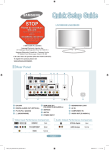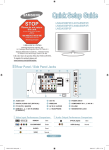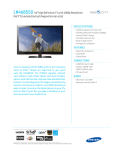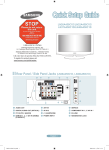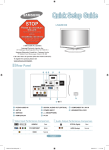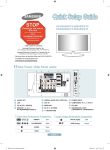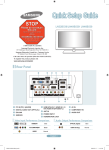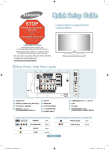Download Samsung LN37B550 User's Manual
Transcript
Quick Setup Guide STOP LNB550/LN7B550/LN40B550/ LN46B550/ LN5B550 Please do not return this unit If you are having problems operating this TV, Please call; 1-00-SAMSUNG (1-00-76-764) For web support please visit www.samsung.com/support 1-800-SAMSUNG (7267864) Samsung Electronics America, Inc. 105 Challenger Road Ridgefield Park, NJ 07660-0511 Samsung Electronics Canada Inc., Customer Service 55 Standish Court Mississauga, Ontario L5R 4B2 Call center hours of operation (Mon-Sun 9AM-12AM EST). To register this product please visit www.samsung.com/register Rear Panel 1 2 3 4 5 1 6 7 ! 0 8 9 1 HDMI IN 1 (DVI), , , 4 / DVI AUDIO IN [R-AUDIO-L] 2 PC IN [PC] / [AUDIO] 3 DIGITAL AUDIO OUT (OPTICAL) 4 EX-LINK 8 ANT IN 5 AUDIO OUT [R-AUDIO-L] 9 COMPONENT IN 1, / AV IN 1 6 USB 0 KENSINGTON LOCK 7 AV IN ! POWER INPUT Video Input Performance Comparison Audio Output Performance Comparison / HDMI/DVI Best OPTICAL (Digital) Best / PC/COMPONENT Better AUDIO (Analog) Normal VIDEO Normal English-1 BN68-01884F-00Eng.indd 1 2009-02-26 �� 4:43:03 Remote Control See “Remote Control” in the owner’s instructions for details. 1 POWER Turns the TV on and off. 2TV Selects the TV mode directly. 3 NUMERIC BUTTONS Press to change the channel. 4 _ Press to select additional channels (digital and analog) being broadcast by the same station. For example, to select channel '54-3', press '54', then press '_' and '3'. 5 MUTE M Press to temporarily cut off the sound. 6 y Press to increase or decrease the volume. 7 CH LIST Used to display Channel Lists on the screen. 8 TOOLS Use to quickly select frequently used functions. 9 INFO Press to display information on the TV screen. 0 COLOR BUTTONS Use these buttons in the Channel list menus etc. ! MEDIA.P Allows you to play music files, pictures, and movies. $ ON/OFF @ Pressing the ON/OFF @ light button toggles between on and off. When the remote control is on, and a button is pressed on the remote control, the remote control buttons will be lit for a moment. (Using the remote control with the ON/OFF @ light button set to On will reduce the battery usage time.) % PRE.CH Enables you to return to the previous channel you were watching. ^ z Press to change channels. & SOURCE Press to display and select the available video sources. * FAV.CH Press to switch to your favorite channels. 1 2 3 4 5 % 6 ^ 7 8 ( MENU Displays the main on-screen menu. ) RETURN Returns to the previous menu. a U P▲ / DOWN▼ / LEFT◄ / RIGHT► / ENTERE Use to select on-screen menu items and change menu values. b EXIT Press to exit the menu. @ P.MODE c P.SIZE Press to select the picture mode. Picture size selection. # Use these buttons in the DMA d SRS and Anynet+ modes. (∏: Selects SRS TruSurround HD This remote can be used to mode. control recording on Samsung recorders with the Anynet+ e CC feature) Controls the caption decoder. $ & * ( ) a 9 b 0 ! @ # c d e f f MTS Press to choose stereo, mono or Separate Audio Program (SAP broadcast). English- BN68-01884F-00Eng.indd 2 2009-02-26 �� 4:43:03 Installing the Stand (LN32B550) Back 2 2 Front 2 1 1 1 1 Place the Guide Stand and Cover Neck onto the stand and fasten it using the three screws. 2 Attach your LCD TV to the stand. ➣ Two or more people should carry the TV. ➣ Make sure to distinguish between the front and back of the stand when attaching it. 3 Fasten two screws at position 1 and then fasten two screws at position 2. Installing the Stand (LN37B550, LN40B550, LN46B550, LN52B550) 2 2 1 1 1 Attach your LCD TV to the stand. ➣ Two or more people should carry the TV. ➣ Make sure to distinguish between the front and back of the stand when attaching it. 2 Fasten two screws at position 1 and then fasten two screws at position 2. English- BN68-01884F-00Eng.indd 3 2009-02-26 �� 4:43:04 Connections Connecting a DVD / Blu-ray player / Cable Box / Satellite receiver (Set-Top Box) via HDMI TV Rear Panel TV Side Panel 1 Connect an HDMI Cable between the HDMI IN 1 (DVI), 2, 3 or 4 jack on the TV and the HDMI jack on the DVD / Blu-ray Player or Cable Box / Satellite receiver (Set-Top Box). What is HDMI? •HDMI(High-Definition Multimedia Interface), is an interface that enables the transmission of digital audio and video signals using a single cable. DVD / Blu-ray player / Cable Box/ Satellite receiver (Set-Top Box) or 1 or •The difference between HDMI and DVI is that the HDMI device is smaller in size and has the HDCP (High Bandwidth Digital Copy Protection) coding feature installed. HDMI Cable (Not supplied) ➣ Each DVD / Blu-ray player / Cable Box / Satellite receiver (Set-Top Box) has a different back panel configuration. ➣ The TV may not output sound and pictures may be displayed with abnormal color when DVD / Blu-ray player / Cable Box / Satellite receiver (Set-Top Box) supporting HDMI versions older than 1.3 are connected. When connecting an older HDMI cable and there is no sound, connect the HDMI cable to the HDMI IN 1 (DVI) jack and the audio cables to the DVI AUDIO IN [R-AUDIO-L] jacks on the back of the TV. If this happens, contact the company that provided the DVD / Blu-ray player / Cable Box / Satellite receiver (Set-Top Box) to confirm the HDMI version, then request an upgrade. ➣ HDMI cables that are not 1.3 may cause annoying flicker or no screen display. Connecting a DVD / Blu-ray player / Cable Box / Satellite receiver (Set-Top Box) via DVI TV Rear Panel 1 Connect a DVI to HDMI Cable or DVIHDMI Adapter between the HDMI IN 1 (DVI) jack on the TV and the DVI jack on the DVD / Blu-ray player / Cable Box / Satellite receiver (Set-Top Box). 2 Connect Audio Cables between the DVI AUDIO IN [R-AUDIO-L] jack on the TV and the DVD / Blu-ray player / Cable Box / Satellite receiver (Set-Top Box). ➣ Each DVD / Blu-ray player / Cable Box / Satellite receiver (Set-Top Box) has a different back panel configuration. DVD / Blu-ray player / Cable Box / Satellite receiver (Set-Top Box) 2 Audio Cable (Not supplied) 1 DVI to HDMI Cable (Not supplied) ➣ When connecting a DVD / Blu-ray player / Cable Box / Satellite receiver (Set-Top Box), match the color of the connection terminal to the cable. ➣ When using an HDMI / DVI cable connection, you must use the HDMI IN 1 (DVI) jack. English- BN68-01884F-00Eng.indd 4 2009-02-26 �� 4:43:06 Connecting a DVD / Blu-ray player / Cable Box / Satellite receiver (Set-Top Box) via Component cables TV Rear Panel DVD / Blu-ray player / Cable Box / Satellite receiver (Set-Top Box) 1 Component Cable (Not supplied) 2 Audio Cable (Not supplied) 1 Connect a Component Cable between the COMPONENT IN (1 or 2) [Y, PB, PR] jacks on the TV and the COMPONENT [Y, PB, PR] jacks on the DVD / Blu-ray player / Cable Box / Satellite receiver (Set-Top Box). 2 Connect Audio Cables between the COMPONENT IN(1 or 2) [R-AUDIO-L] jacks on the TV and the AUDIO OUT jacks on the DVD / Blu-ray player / Cable Box / Satellite receiver (Set-Top Box). ➣ Component video separates the video into Y (Luminance (brightness)), Pb (Blue) and Pr (Red) for enhanced video quality. Be sure to match the component video and audio connections. For example, if connecting a Component video cable to COMPONENT IN 1, connect the audio cable to COMPONENT IN 1 also. ➣ Each DVD / Blu-ray player / Cable Box / Satellite receiver (Set-Top Box) has a different back panel configuration. ➣ When connecting a DVD / Blu-ray player / Cable Box / Satellite receiver (Set-Top Box), match the color of the connection terminal to the cable. Connecting a VCR 1 TV Rear Panel TV Side Panel VCR Rear Panel 2 Audio Cable (Not supplied) 1 Video Cable (Not supplied) 2 Connect a Video Cable between the AV IN 1 [Y/VIDEO] or AV IN 2 [VIDEO] jack on the TV and the VIDEO OUT jack on the VCR. Connect Audio Cables between the AV IN (1 or 2) jacks on the TV and the AUDIO OUT jacks on the VCR. ➣ If you have a ‘mono’ (non-stereo) VCR, use a Y-connector (not supplied) to connect to the right and left audio input jacks of the TV. Alternatively, connect the cable to the ‘R’ jack. If your VCR is stereo, you must connect two cables. ➣ Each VCR has a different back panel configuration. ➣ When connecting a VCR, match the color of the connection terminal to the cable. ➣ When connecting to AV IN 1, the color of the AV IN 1 [Y/VIDEO] jack (Green) does not match the color of the video cable (Yellow). English- BN68-01884F-00Eng.indd 5 2009-02-26 �� 4:43:07 Connecting a Digital Audio System 1 TV Rear Panel Digital Audio System 1 Connect an Optical Cable between the DIGITAL AUDIO OUT (OPTICAL) jacks on the TV and the Digital Audio Input jacks on the Digital Audio System. Optical Cable (Not supplied) ➣ When a Digital Audio System is connected to the DIGITAL AUDIO OUT (OPTICAL) jack: Decrease the volume of the TV and adjust the volume level with the system’s volume control. ➣ 5.1CH audio is possible when the TV is connected to an external device supporting 5.1CH. ➣ Each Digital Audio System has a different back panel configuration. ➣ When the Home Theater receiver is set to On, you can hear sound output from the TV’s Optical jack. When the TV is displaying a DTV(air) signal, the TV will send out 5.1 channel sound to the Home theater receiver. When the source is a digital component such as a DVD / Blu-ray player / Cable Box / Satellite receiver (Set-Top Box) and is connected to the TV via HDMI, only 2 channel sound will be heard from the Home Theater receiver. If you want to hear 5.1 channel audio, connect the digital audio out jack on DVD / Blu-ray player / Cable Box / Satellite receiver (Set-Top Box) directly to an Amplifier or Home Theater, not the TV. Connecting an Amplifier / DVD Home Theater 1 TV Rear Panel Connect Audio Cables between the AUDIO OUT [R-AUDIO-L] jacks on the TV and Audio Input jacks on the Amplifier / DVD Home Theater. Amplifier/DVD Home Theater ➣ When an audio amplifier is connected to the AUDIO OUT [R-AUDIO-L] jacks: Decrease the volume of the TV and adjust the volume level with the Amplifier’s volume control. ➣ Each Amplifier/DVD Home Theater has a different back panel configuration. 1 ➣ When connecting an Amplifier/DVD Home Theater, match the color of the connection terminal to the cable. Audio Cable (Not supplied) English- BN68-01884F-00Eng.indd 6 2009-02-26 �� 4:43:08 Connecting a Camcorder Using a Video Cable TV Side Panel 1 Connect a Video Cable between the AV IN 2 [VIDEO] jack on the TV and the VIDEO OUT jack on the camcorder. 2 Connect Audio Cables between the AV IN 2 [R-AUDIO-L] jacks on the TV and the AUDIO OUT jacks on the camcorder. Camcorder 1 Video Cable (Not supplied 2 Audio Cable (Not supplied) ➣ Each Camcorder has a different back panel configuration. ➣ When connecting a Camcorder, match the color of the connection terminal to the cable. Using an HDMI Cable TV Side Panel 1 Connect an HDMI Cable between the HDMI 4 jack on the TV and the HDMI OUT jack on the camcorder. HD Camcorder 1 HDMI Cable (Not supplied) English- BN68-01884F-00Eng.indd 7 2009-02-26 �� 4:43:08 Connecting a PC Using a D-Sub Cable Using a D-Sub Cable TV Rear Panel 1 Connect a D-Sub Cable between PC IN [PC] connector on the TV and the PC output connector on your computer. 2 Connect a PC Audio Cable between the PC IN [AUDIO] jack on the TV and the Audio Out jack of the sound card on your computer. ➣ When connecting a PC, match the color of the connection terminal to the cable. PC 2 1 PC Audio Cable (Not supplied) D-Sub Cable (Not supplied) Using an HDMI/DVI Cable Using an HDMI/DVI Cable TV Rear Panel 1 2 ➣ When using an HDMI/DVI cable connection, you must use the HDMI IN 1 (DVI) terminal. PC 1 Connect an HDMI/DVI cable between the HDMI IN 1 (DVI) jack on the TV and the PC output jack on your computer. Connect a 3.5 mm Stereo miniplug / 2RCA Cable between the DVI AUDIO IN [R-AUDIO-L] jack on the TV and the Audio Out jack of the sound card on your computer. HDMI/DVI Cable (Not supplied) 3.5 mm Stereo mini-plug/ 2RCA Cable (Not supplied) 2 Using an HDMI Cable Using an HDMI Cable TV Rear Panel TV Side Panel 1 Connect an HDMI cable between the HDMI IN 1 (DVI), 2, 3 or 4 jack on the TV and the PC output jack on your computer. ➣ Each PC has a different back panel configuration. PC or 1 or HDMI Cable (Not supplied) English- BN68-01884F-00Eng.indd 8 2009-02-26 �� 4:43:10 Turning the TV On and Off 4 Press the POWER button on the remote control. You can also use the POWER button on the TV. Viewing the Menus When selecting the Cable TV system: Press the ENTERE button to start the auto program. Press the ▲,▼, ◄ or ► to select the correct analog signal cable system source among “STD”, “HRC”, and “IRC”. Press the ▲ or ▼ button to select “Start”, then press the ENTERE button. If you have Digital cable TV, select the cable system signal source for both Analog and Digital. Auto Program Selects the cable system. Analog STD HRC IRC Digital STD HRC IRC Start U Move 5 1 With the power on, press the MENU button. The main menu appears on the screen. The menu’s left side has the following icons: Picture, Sound, Channel, Setup, Input, Application, Support. 2 Press the ▲ or ▼ button to select one of the icons. Then press the ENTERE button to access the icon’s sub-menu. Press the EXIT button to exit. E Enter m Skip The TV begins memorizing all available stations. Press the EXIT button to exit. Auto Program Auto Program in Progress. Cable 38 50% DTV Cable : 12 Cable : 32 Stop E Enter m Skip Auto Program ➣ The on-screen menus disappear from the screen after about one minute. Removing scrambled channel. DTV Cable 41 77% DTV Cable : 16 Cable : 45 Stop E Enter Storing Channels in Memory (Automatic Method) ➣ After all the available channels are stored, it starts to remove scrambled channels. The Auto program menu then reappears. 1 Press the MENU button to display the menu. Press the ▲ or ▼ button to select “Channel”, then press the ENTERE button. 2 Press the ▲ or ▼ button to select “Auto Program”, then press the ENTERE button. 3 Press the ▲ or ▼ button to select the antenna connection, then press the ENTERE button. To Stop the Auto Program Function Auto Program Select the Antenna source to memorize. Air Start Cable Start Auto Start U Move m Skip E Enter Press the MENU button while the Auto Program function is being executed. You can also press the ENTERE button to stop the setup. Checking to see if Channels were Stored in Memory m Skip Press the CH button. Only the channels stored in memory will be selected (in order). Selecting the antennas • Air: “Air” antenna signal. • Cable: “Cable” antenna signal. • Auto: “Air” and “Cable” antenna signals. English- BN68-01884F-00Eng.indd 9 2009-02-26 �� 4:43:11 Setting the Channel List Changing the Picture Standard You can delete or add a channel to display the channels you want. You can select the type of picture which best corresponds to your viewing requirements. Press the MENU button. Press the ▲ or ▼ button to select “Channel”, then press the ENTERE button. Press the ▲ or ▼ button to select “Channel List”, then press the ENTERE button. 2 Press the ◄ button to select “Added Channels”. Press the ▲ or ▼ button to select “All Channels”. Press the ENTERE button. 3 Press the ▲ or ▼ button to select a channel to delete, then press the TOOLS button. Press the ENTERE button to select “Delete”. 4 Press the ▲ or ▼ button to select a channel to add, then press the TOOLS button. Press the ENTERE button and the channel is added. All Channels 2 Air 4 Air Delete Add to Favorite 4-2 ♥ TV #8 8 Air 13 Air Zoom Press the MENU button to display the menu. Press the ENTERE button, to select “Picture”. 2 Press the ENTERE button to select “Mode”. Press the ▲ or ▼ button to select “Dynamic”, “Standard” or “Movie”. Press the ENTERE button. Mode :Standard ► Dynamic Contrast Standard :7 Movie : 95 Brightness : 45 Sharpness : 50 Color : 50 Tint (G/R) : G50/R50 Backlight Timer Viewing Channel Name Edit Picture Mode Select All 13-1 ♥ TV #3 Alice’s Adventures in Wonderland Auto Program Air 1 Picture 1 Select T Tools Setting Your Favorite Channels You can set channels you watch frequently as favorites. 1 Press the MENU button. Press the ▲ or ▼ button to select “Channel”, then press the ENTERE button. Press the ▲ or ▼ button to select “Channel List”, then press the ENTERE button. 2 Press the ◄ button to select “Added Channels”. Press the ▲ or ▼ button to select “All Channels”. Press the ENTERE button. 3 Press the ▲ or ▼ button to select a channel as a favorite channel. Press the TOOLS button. 4 Press the ▲ or ▼ button to select “Add to Favorite”, then press the ENTERE button. The “♥” symbol will be displayed and the channel will be set as a favorite. •D ynamic: Selects the picture for high-definition in a bright room. • Standard: Selects the picture for the optimum display in a normal environment. • Movie: Selects the picture for viewing movies in a dark room. ➣ The "♥" symbol will be displayed and the channel will be set as a favorite. ➣ All favorite channels will be shown in the "Favorite" menu. All Channels 2 Air 4 Air Delete Add to Favorite 4-2 ♥ TV #8 8 Air 13 Air Timer Viewing Channel Name Edit Select All 13-1 ♥ TV #3 Alice’s Adventures in Wonderland Auto Program Air Zoom Select T Tools English-10 BN68-01884F-00Eng.indd 10 2009-02-26 �� 4:43:11 Customizing the Picture Settings Setting the Screen Size Your television has several setting options that allow you to control the picture quality. Occasionally, you may want to change the size of the image on your screen. Your TV comes with six screen size options, each designed to work best with specific types of video input. Your cable box or satellite receiver may have its own set of screen sizes as well. In general, though, you should view the TV in 16:9 mode as much as possible. 1 To select the desired picture mode, follow the “Changing the Picture Standard” instructions numbers 1 and 2. 2 Press the ▲ or ▼ button to select “Backlight”, “Contrast”, “Brightness”, “Sharpness”, “Color” or “Tint(G/R)”, then press the ENTERE button. 1 To select the desired picture mode, follow the “Changing the Picture Standard” instructions number 1. 3 ress the ◄ or ► button to decrease or increase P the value of a particular item. Press the EXIT button to exit. 2 ➣ W hen you make changes to “Backlight”, “Contrast”, “Brightness”, “Sharpness”, “Color” or “Tint(G/R)”, the OSD will be adjusted accordingly. Press the ▲ or ▼ button to select “Picture Options”, then press the ENTERE button. Press the ▲ or ▼ button to select “Size”, then press the ENTERE button. 3 Press the ▲ or ▼ button to select the screen format you want. Press the ENTERE button. Press the EXIT button to exit. ➣ In PC mode, you can only make changes to “Backlight”, “Contrast” and “Brightness”. ➣ Settings can be adjusted and stored for each external device you have connected to an input of the TV. ➣ The energy consumed during use can be significantly reduced if the brightness level of the picture is lowered, which will reduce the overall running cost. Picture Mode : Standard Backlight : 8 Contrast : 95 Brightness : 45 Sharpness : 50 Color : 50 Tint (G/R) : G50/R50 • 16:9: Sets the picture to 16:9 wide mode. • Zoom1: Magnifies the size of the picture on the screen. • Zoom2: Magnifies the size of the picture more than “Zoom1”. • Wide Fit: Enlarges the aspect ratio of the picture to fit the entire screen. • 4:3: Sets the picture to 4:3 normal mode. •S creen Fit: Use the function to see the full image without any cutoff when HDMI (720p/1080i/1080p), Component (1080i/1080p) or DTV (1080i) signals are input. ► Advanced Settings Backlight Move 8 Adjust Enter Return Picture Adjustment •B acklight: Adjusts the brightness of LCD back light. • Contrast: Adjusts the contrast level of the picture. •B rightness: Adjusts the brightness level of the picture. •S harpness: Adjusts the edge definition of the picture. •C olor: Adjusts color saturation of the picture. • Tint(G/R): Adjusts the color tint of the picture. English-11 BN68-01884F-00Eng.indd 11 2009-02-26 �� 4:43:11 To Select the Source TV AV1 ---- AV2 ---- Component1 ---- Component2 ---- PC ---- Refresh T Tools Press the SOURCE button on the Remote Control You can select the TV mode or an input source connected to the TV set. Use this button to choose an input source that you would like to watch. ➣ Available signal sources: TV, AV1, AV2, Component1, Component2, PC, HDMI1/DVI, HDMI2, HDMI3. (LN52B550) TV, AV, Component, PC, HDMI1/DVI, HDMI2, HDMI3. (LN32B550, LN37B550, LN40B550, LN46B550) ➣ You can choose only those external devices that are connected to the TV. In the “Source List”, connected inputs will be highlighted and sorted to the top. Inputs that are not connected will be sorted to the bottom. ➣ Using the Color buttons on the remote with the Source list •R ed (Refresh): Refreshes the connected external devices. Press this if your Source is on and connected, but does not appear in the list. • TOOLS (Tools): Displays the “Edit Name” and “Information” menus. English-12 BN68-01884F-00Eng.indd 12 2009-02-26 �� 4:43:11 Troubleshooting If the TV seems to have a problem, first try this list of possible problems and solutions. If none of these troubleshooting tips apply, call Samsung customer service at 1-800-SAMSUNG. (726-7864) Problem Possible Solution Poor picture Try another channel. / Adjust the antenna. / Check all wire connections. Poor sound quality. Try another channel. / Adjust the antenna. No picture or sound. Try another channel. / Press the SOURCE button. / Make sure the TV is plugged in. / Check the antenna connections. No sound or sound is too low at maximum volume. First, check the volume of units connected to your TV (digital broadcasting receiver, DVD, cable broadcasting receiver, VCR, etc.). Then, adjust the TV volume accordingly. Picture rolls vertically. Check all wire connections. There is a problem with the picture Run the Picture test in the Self diagnostic menu. There is a problem with the sound Run the Sound test in the Self diagnostic menu. The TV operates erratically. Unplug the TV for 30 seconds, then try operating it again. The TV won’t turn on. Make sure the wall outlet is working. Remote control malfunctions Replace the remote control batteries. Clean the upper edge of the remote control (transmission window). Check the battery terminals. 'Check signal cable' message. Ensure that the signal cable is firmly connected to the PC source. 'Not Supported Mode' message. Check the maximum resolution and connected device’s Video frequency. Compare these values with the data in the Display Modes. Digital broadcasting screen problem. Please check the digital signal strength and input antenna. The image is too light or too dark. Adjust the Brightness and Contrast. / Adjust the Fine tuning. Black bars on the screen. Make sure the broadcast you’re receiving is High Definition (HD). HD channels sometimes broadcast Standard Definition (SD) programming, which can cause black bars. Set your cable/satellite box to stretch or widescreen mode to eliminate the bars. Picture has a Red/Green or Pink tint. Make sure the Component cables are connected to the correct jacks. Closed Captioning not working. If you are using a Cable/Satellite box, you must set Closed Captioning on the box, not your TV. Snowy picture. Your cable box may need a firmware upgrade. Please contact your Cable company. Ghosting on picture This is sometimes caused by compatibility issues with your cable box. Try connecting Component cables instead. Horizontal bars appear to flicker, jitter or shimmer on the image. Adjust the Coarse tuning and then adjust the Fine tuning. Vertical bars appear to flicker, jitter or shimmer on the image. Adjust the Coarse tuning and then adjust the Fine tuning. Screen is black and power indicator light blinks steadily. On your computer check: Power, Signal Cable. The TV is using its power management system. Move the computer's mouse or press any key on the keyboard. Image is not centered on the screen. Adjust the horizontal and vertical position. The screen position must be adjusted on the output source (i.e. STB) with a digital signal. The picture appears distorted in the corner of the screen. If "Just Scan" is selected with some external devices, the picture may appear distorted in the corner of the screen. This symptom is caused by the external devices, not TV. The 'Resets all settings to the default values' message appears. This appears when you press and hold the EXIT button for a while. The product settings are reset to the factory defaults. English-13 BN68-01884F-00Eng.indd 13 2009-02-26 �� 4:43:11 Guide d'installation rapide STOP LNB550/LN7B550/LN40B550/ LN46B550/ LN5B550 Veuillez SVP ne pas retourner cet appareil. En cas de problèmes de fonctionnement, veuillez composer le numéro suivant : 1-00-SAMSUNG (1-00-76-764) Pour obtenir de l’assistance en ligne, allez au lien suivant : www.samsung.com/support 1-800-SAMSUNG (7267864) Samsung Electronics America, Inc. 105 Challenger Road Ridgefield Park, NJ 07660-0511 Samsung Electronics Canada Inc., Customer Service 55 Standish Court Mississauga, Ontario L5R 4B2 Centre d’appel – heures de service (du lundi au dimanche, de 9 h à 12 h (HNE) Pour enregistrer ce produit, veuillez SVP aller à : www.samsung.com/register Panneau arrière 1 2 3 4 5 1 6 7 ! 0 8 9 1 HDMI IN 1 (DVI), , , 4 / DVI AUDIO IN [R-AUDIO-L] 2 PC IN [PC] / [AUDIO] 3 DIGITAL AUDIO OUT (OPTICAL) 4 EX-LINK 8 ANT IN 5 AUDIO OUT [R-AUDIO-L] 9 COMPONENT IN 1, / AV IN 1 6 USB 0 VERROU KENSINGTON 7 AV IN ! PUISSANCE CONSOMMÉE Entrée vidéo – tableau comparatif des performances Sortie audio – tableau comparatif des performances / HDMI/DVI La meilleure OPTICAL (Digital) La meilleure / PC/COMPONENT Excellente AUDIO (Analog) Normale VIDEO Normale Français-1 BN68-01884F-00Eng.indd 1 2009-02-26 �� 4:43:14 Télécommande Reportez-vous à la section "Télécommande" du guide de l’utilisateur pour plus de détails. 1 POWER : Permet d’allumer et d’éteindre le téléviseur. 2 TV: Permet de sélectionner directement le mode TV. 3 TOUCHES NUMÉRIQUES : Appuyer sur cette touche pour changer de canal. 4 _ : Appuyer sur cette touche pour sélectionner des canaux supplémentaires (numériques) diffusées par la même station. Par exemple, pour sélectionner le canal ‘54-3’, appuyez sur ‘54’, puis sur _ et ‘3’. 5 MUTE M : Appuyer sur cette touche pour couper le son temporairement. 6 y : Appuyer sur cette touche pour augmenter ou baisser le volume. 7 CH LIST : Sert à afficher la liste des canaux à l'écran. 8 TOOLS : Sert à sélectionner rapidement les fonctions fréquemment utilisées. 9 INFO : Appuyer sur cette touche pour afficher de l'information à l'écran. 0 TOUCHES DE COULEUR : Utiliser ces touches dans les menus de liste de canaux, etc. ! MEDIA.P: Appuyez sur cette touche pour lire des fichiers musicaux, des images et des films. @ P.MODE: Appuyer sur cette touche pour sélectionner le mode d'image. # Ces touches fonctionnent dans les modes DMA et Anynet+. (∏ : Cette télécommande peut servir à commander l’enregistrement sur des enregistreurs Samsung avec la fonction Anynet+). $ ON/OFF @: Appuyez sur la touche ON/OFF @ pour activer et désactiver le rétroéclairage. Lorsque la télécommande est activée et que vous appuyez sur une de ses touches, ces dernières sont rétroéclairées pendant un moment. (L’utilisation de la télécommande lorsque la touche de rétroéclairage ON/OFF @ est réglée à On réduit la durée de vie des piles.) % PRE-CH: Permet de revenir au canal écouté précédemment. ^ z : Appuyer sur cette touche pour changer de canal. & SOURCE: Appuyer sur cette touche pour afficher et sélectionner les sources vidéo disponibles. * FAV.CH: Appuyer sur cette touche pour naviguer entre vos canaux favoris. ( MENU: Affiche le menu à l’écran principal. ) RETURN: Permet de retourner au menu précédent. a HAUT▲/BAS▼/GAUCHE◄/ DROIT►/ENTERE: Sert à sélectionner des articles de menus affichés et à modifier les valeurs des menus. b EXIT: Appuyer sur cette touche pour sortir du menu. c P.SIZE: Permet de sélectionner le format de l'image. d SRS: Permet de sélectionner le mode SRS TruSurround HD mode. e CC: Permet de commander la fonction de sous-titrage. f MTS: Appuyer sur cette touche pour sélectionner le mode stéréo, mono ou SAP (Separate Audio Program). 1 2 $ 3 4 5 % 6 ^ 7 8 & * ( ) a 9 b 0 ! @ # c d e f Français- BN68-01884F-00Eng.indd 2 2009-02-26 �� 4:43:14 Installation du support (LN32B550) Arrière 2 2 Avant 2 1 1 1 1 Placez le guide de support et le collet sur le support et fixez-les à l’aide des vis. 2 Fixez votre téléviseur ACL sur le support. ➣ Deux personnes ou plus devraient porter le téléviseur. ➣ S’assurer de bien distinguer le devant et l’arrière du support lors de l’assemblage. 3 Vissez les vis à la position 1, puis vissez les vis à la position 2. Installation du support (LN37B550, LN40B550, LN46B550, LN52B550) 2 2 1 1 1 Fixez votre téléviseur ACL sur le support. ➣ Deux personnes ou plus devraient porter le téléviseur. ➣ S’assurer de bien distinguer le devant et l’arrière du support lors de l’assemblage. 2 Vissez les vis à la position 1, puis vissez les vis à la position 2. Français- BN68-01884F-00Eng.indd 3 2009-02-26 �� 4:43:15 Conexions Branchement d’un lecteur DVD/Blu-ray/câblosélecteur ou récepteur satellite (boîtier décodeur) via HDMI Panneau arrière du téléviseur Panneau latéral du téléviseur 1 Branchez un câble HDMI entre la prise HDMI IN 1 (DVI), 2, 3 ou 4) du téléviseur et la prise HDMI du lecteur DVD/Bluray/câblosélecteur ou récepteur satellite (boîtier décodeur). Qu'est-ce que le mode HDMI? •HDMI ou (interface multimédia haute définition) est une interface de transmission de signaux numériques audio et vidéo par un seul câble. Panneau arrière d’un lecteur DVD/ Blu-ray/câblosélecteur ou récepteur satellite (boîtier décodeur) •La distinction entre les interfaces HDMI et DVI réside dans le fait qu'un apapreil HDMI est plus petit et qu'il est doté du composant de codage HDCP (protection contre la copie numérique à large bande passante). ou 1 ou Câble HDMI (non fourni) ➣ La configuration du panneau arrière de chaque lecteur DVD/Blu-ray/ câblosélecteur ou récepteur satellite (boîtier décodeur) diffère. ➣ Le téléviseur peut n’émettre aucun son et les couleurs des images s’afficher anormalement lorsqu’un lecteur DVD/Blu-ray/ câblosélecteur ou récepteur satellite (boîtier décodeur) comporte une version HDMI antérieure à 1.3. Lorsque vous branchez un câble HDMI doté d’une version antérieure et qu’aucun son n’est émis, branchez le câble HDMI à la prise HDMI IN 1 (DVI) et les câbles audio aux prises DVI AUDIO IN (HDMI1) [R-AUDIO-L] situées à l’arrière du téléviseur. Le cas échéant, communiquez avec le fournisseur du lecteur DVD/Blu-ray/câblosélecteur ou récepteur satellite afin de confirmer la version HDMI et demander une mise à niveau. ➣ Les câbles HDMI autres que ceux de version 1.3 peuvent provoquer un papillotement ou une absence d'image. Branchement d’un lecteur DVD/Blu-ray/câblosélecteur ou récepteur satellite (boîtier décodeur) via DVI Panneau arrière du téléviseur Branchez un câble DVI vers HDMI ou un adaptateur DVI-HDMI entre la prise HDMI IN 1 (DVI) du téléviseur et la prise DVI du lecteur DVD/Blu-ray/du câblosélecteur ou du récepteur satellite (boîtier décodeur). 2 Branchez les câbles audio entre la prise DVI AUDIO IN [R-AUDIO-L] du téléviseur et le lecteur DVD/Blu-ray/le câblosélecteur ou le récepteur satellite (boîtier décodeur). ➣ La configuration du panneau arrière de chaque lecteur DVD/Blu-ray/ câblosélecteur ou récepteur satellite (boîtier décodeur) diffère. Lecteur DVD/Blu-ray/câblosélecteur ou récepteur satellite (boîtier décodeur) 2 Câble audio (non fourni) 1 Câble DVI vers HDMI (non fourni) Français- BN68-01884F-00Eng.indd 4 1 ➣ Lorsque vous branchez un lecteur DVD/Blu-ray/câblosélecteur ou récepteur satellite (boîtier décodeur), assurez-vous que la couleur de la prise correspond à celle du câble. ➣ Utilisez la prise d’entrée HDMI IN 1 (DVI) dans le cas d’un branchement HDMI/DVI. 2009-02-26 �� 4:43:17 Branchement d’un lecteur DVD/Blu-ray/câblosélecteur ou récepteur satellite (boîtier décodeur) via les câbles de composantes 1 Panneau arrière du téléviseur Lecteur DVD/Blu-ray/ câblosélecteur ou récepteur satellite (boîtier décodeur) 1 Câble de composante (non fourni) 2 Câble audio (non fourni) Branchez un câble composant entre les prises COMPONENT IN (1 ou 2) [Y, PB, PR] du téléviseur et les prises COMPONENT [Y, PB, PR] du lecteur DVD/Blu-ray/câblosélecteur ou récepteur satellite (boîtier décodeur). Branchez les câbles audio entre les prises COMPONENT IN(1 ou 2) [RAUDIO-L] du téléviseur et les prises AUDIO OUT du lecteur DVD/Blu-ray/ câblosélecteur ou récepteur satellite (boîtier décodeur). ➣ La composante vidéo décompose le signal selon les caractéristiques Y (Luminosité), Pb (Bleu) et Pr (Rouge) afin d'améliorer l'image. Assurezvous de faire correspondre la composante vidéo et les connexions audio. Par exemple, si un câble vidéo composante est branché à COMPONENT IN 1, le câble audio doit être branché à COMPONENT IN 1 également. 2 ➣ La configuration du panneau arrière de chaque lecteur DVD/Blu-ray/câblosélecteur ou récepteur satellite (boîtier décodeur) diffère. ➣ Lorsque vous branchez un lecteur DVD/Blu-ray/câblosélecteur ou récepteur satellite (boîtier décodeur), assurez-vous que la couleur de la prise correspond à celle du câble. Connexion d'un magnétoscope 1 Panneau arrière du téléviseur Panneau latéral du téléviseur Panneau arrière du magnétoscope 2 Câble audio (non fourni) 1 Câble vidéo (non fourni) 2 Branchez un câble vidéo entre la prise AV IN 1 [Y/VIDEO] ou AV IN 2 [VIDEO] du téléviseur et la prise VDEO OUT du magnétoscope. Branchez les câbles audio entre les prises AV IN (1 ou 2) du téléviseur et les prises AUDIO OUT du magnétoscope. ➣ Si le magnétoscope est de type ‘mono’ (non stéréo), il faut utiliser un connecteur en Y (non fourni) pour effectuer les connexions aux prises d'entrée audio droite et gauche du téléviseur. l est également possible de brancher le câble à la prise ‘R’. Si le magnétoscope est de type ‘stéréo’, il faut brancher deux câbles. ➣ Chaque magnétoscope possède une configuration de panneau arrière différente. ➣ Lorsque vous branchez magnétoscope, assurez-vous que la couleur de la prise correspond à celle du câble. ➣ Dans le cas de la connexion à AV IN 1, la couleur de la prise AV IN 1 [Y/VIDEO] (vert) ne correspond pas à la couleur du câble vidéo (jaune). Français- BN68-01884F-00Eng.indd 5 2009-02-26 �� 4:43:18 Connexion d'une chaîne audio numérique 1 Panneau arrière du téléviseur Chaîne audio numérique 1 Branchez un câble optique entre les prises DIGITAL AUDIO OUT (OPTICAL) du téléviseur et les prises d'entrée audio numérique de la chaîne. Câble optique (non fourni) ➣ Lorsqu'une chaîne audionumérique est branchée à la prise DIGITAL AUDIO OUT (OPTICAL) : baissez le volume du téléviseur, puis réglez le volume à l'aide de la commande de volume de la chaîne. ➣ La diffusion audio à 5.1 canaux est possible lorsque le téléviseur est raccordé à un appareil externe doté de cette fonction audio. ➣ La configuration du panneau arrière de chaque système audio numérique diffère. ➣ Lorsque le récepteur de la chaîne de cinéma maison est réglé à On, vous pouvez entendre le son provenant de la prise optique du téléviseur. Lorsque le téléviseur émet des signaux numériques (air), il transmet le son en 5.1 canaux au récepteur de la chaîne de cinéma maison. Lorsque la source est un composant numérique, comme un lecteur DVD/Blu-ray/câblosélecteur ou récepteur satellite (boîtier décodeur), et que ce dernier est branché au téléviseur par un câble HDMI, le récepteur de la chaîne de cinéma maison ne fera entendre qu’un son à deux canaux. Si vous désirez entendre un son à 5.1 canaux, branchez directement la prise de sortie audionumérique du lecteur DVD/Blu-ray/câblosélecteur ou récepteur satellite (boîtier décodeur) à l’amplificateur ou à la chaîne de cinéma maison, plutôt qu’au téléviseur. Connexion d'un amplificateur/lecteur DVD de cinéma maison 1 Panneau arrière du téléviseur Amplificateur/ lecteur DVD de cinéma maison 1 Branchez un câble audio entre les prises AUDIO OUT [R-AUDIO-L] du téléviseur et les prises d'entrée audio de l'amplificateur/ lecteur DVD de cinéma maison. ➣ Lorsqu'un amplificateur audio est branché aux prises de sortie gauche et droite AUDIO OUT [RAUDIO-L] : Baissez le volume du téléviseur et réglez le volume à l’aide de la commande de volume de l’amplificateur. ➣ La configuration du panneau arrière de chaque amplificateur/lecteur DVD de cinéma maison diffère. Câble audio (non fourni) ➣ Lorsque vous connectez un amplificateur/lecteur DVD de cinéma maison, assurez-vous que la couleur de la prise correspond à celle du câble. Français- BN68-01884F-00Eng.indd 6 2009-02-26 �� 4:43:20 Connexion d'un caméscope Utilisation d’un câble vidéo Panneau latéral du téléviseur Caméscope 1 Câble vidéo (non fourni) 2 Câble audio (non fourni) 1 Branchez un câble vidéo entre la prise AV IN 2 [VIDEO] du téléviseur et la prise VDEO OUT du caméscope. 2 Branchez les câbles audio entre les prises AV IN 2 [R-AUDIO-L] du téléviseur et les prises AUDIO OUT du caméscope. ➣ La configuration arrière de chaque caméscope est différente suivant les appareils. ➣ Lorsque vous branchez un caméscope, assurez-vous que la couleur de la prise correspond à celle du câble. Utilisation d’un câble HDMI Panneau latéral du téléviseur 1 Branchez un câble HDMI entre la prise HDMI 4 du téléviseur et la prise HDMI OUT du caméscope. Caméscope HD 1 Câble HDMI (non fourni) Français- BN68-01884F-00Eng.indd 7 2009-02-26 �� 4:43:20 Connexion d'un PC Utilisation d’un câble secondaire D Utilisation d’un câble secondaire D Panneau arrière du téléviseur 1 Branchez un câble secondaire D entre le connecteur PC IN [PC] du téléviseur et le connecteur de sortie PC de votre ordinateur. 2 Branchez un câble audio PC entre la prise PC IN [AUDIO] du téléviseur et la prise de sortie audio de la carte son de l'ordinateur. ➣ Lorsque vous connectez un PC, assurez-vous que la couleur de la prise correspond à celle du câble. PC 2 1 Câble audio de PC (non fourni) Câble secondaire D (non fourni Utilisation d’un câble HDMI/DVI Utilisation d’un câble HDMI/DVI Panneau arrière du téléviseur 1 2 ➣ Il faut utiliser la borne d’entrée HDMI IN 1 (DVI) dans le cas d’un branchement à l’aide d’un câble HDMI/DVI. PC 1 2 Connectez un câble HDMI/DVI entre la prise HDMI IN 1 (DVI) du téléviseur et la prise de sortie PC de l'ordinateur. Branchez un câble mini-prise stéréo 3,5 mm/2RCA entre la prise DVI AUDIO IN [R-AUDIO-L] du téléviseur et la prise de sortie audio de la carte son de l’ordinateur. Câble HDMI/DVI (non fourni) Câble mini-prise stéréo 3,5 mm/2RCA (non fourni) Utilisation d’un câble HDMI Panneau arrière du téléviseur Utilisation d’un câble HDMI Panneau latéral du téléviseur 1 Connectez un câble HDMI entre la prise HDMI IN 1 (DVI), 2, 3 ou 4 du téléviseur et la prise de sortie PC de l'ordinateur. ➣ La configuration du panneau arrière de chaque PC diffère. PC ou 1 ou Câble HDMI (non fourni) Français- BN68-01884F-00Eng.indd 8 2009-02-26 �� 4:43:22 Mise en marche et arrêt de la télévision Appuyez sur le bouton POWERP de la télécommande. Il est aussi possible d’utiliser la touche POWERP du téléviseur. 4 Au moment de la sélection du système de télévision par Câble : Appuyez sur ENTERE pour amorcer la mémorisation automatique. Appuyer sur les touches ▲,▼, ◄ ou ► pour choisir la source du signal analogique appropriée “STD”, “HRC”, ou “IRC”. Appuyer sur la touche ▲ ou ▼ pour sélectionner “Démarrer”, puis sur ENTERE. Si le Câble est numérique, sélectionner la source de signal pour une diffusion analogique et numérique. Visualisation des menus Prog. auto Choisir le tableau de câblodiffusion. Analogique STD HRC IRC Numérique STD HRC IRC Démarrer U Dépl. 5 1 2 Une fois l’appareil allumé, appuyez sur le bouton MENU. Le menu principal apparaît à l’écran. La partie gauche du menu comprend les icônes suivantes : Image, Son, Chaîne, Configuration, Entrée, Support technique. Appuyer sur la touche ▲ ou ▼ pour sélectionner une des icônes. Puis appuyez sur ENTERE pour accéder au sous-menu de l’icône. Appuyez sur le bouton EXIT pour quitter. ➣ Les menus affichés à l’écran disparaissent après une minute environ. Enregistrement des canal dans la mémoire (méthode automatique) 1 Appuyez sur le bouton MENU pour afficher le menu. Appuyez sur les bouton ▲ ou ▼ pour sélectionner “Chaîne”, puis appuyez sur le bouton ENTERE. 2 Appuyez sur les bouton ▲ ou ▼ pour sélectionner “Prog. auto”, puis appuyez sur le bouton ENTERE. 3 Utilisez les bouton ▲ ou ▼ pour sélectionner l’antenne souhaitée, puis appuyez sur le bouton ENTERE. Prog. auto Démarrer Câble Démarrer Auto Démarrer U Dépl. E Intro. m Passer Le téléviseur commence alors à mémoriser tous les canaux disponibles. Appuyez sur le bouton EXIT pour quitter. Prog. auto Progr. Aut. en cours Câble 38 50% DTV Câble : 12 Câble : 32 Stop E Enter m Skip Prog. auto Removing scrambled channel. DTV Câble : 16 Câble : 45 DTV Câble 41 77% Stop E Enter m Skip ➣ Une fois tous les canaux mémorisés, le téléviseur commence à éliminer les canaux brouillés. Puis le menu Prog. auto s’affiche. Pour arrêter la fonction de programmation automatique Appuyez sur la touche MENU pendant que la fonction de programmation automatique est en cours d’exécution. Vous pouvez également appuyer sur ENTERE pour interrompre la configuration. Mémoriser une source d'antenne. Air E Intro. Pour vérifier si les canaux ont été mémorisés m Passer Appuyez sur la touche CH. Seuls les canaux mémorisés seront sélectionnés (dans l’ordre). Sélection du mode de réception • Air : Signal d'antenne de type “Air”. • Câble : signal d'antenne de type “Câble”. • Auto : Signaux d'antenne de type “Air” et “Câble”. Français- BN68-01884F-00Eng.indd 9 2009-02-26 �� 4:43:23 Réglage de la liste de canaux Changement du format normal de l’image Il est possible d’ajouter ou de supprimer un canal pour afficher seulement les canaux désirés. Il est possible de choisir le type d’image qui correspond le plus à ses exigences. Appuyez sur le bouton MENU. Appuyez sur les bouton ▲ ou ▼ pour sélectionner “Chaîne”, puis appuyez sur le bouton ENTERE. Appuyez sur les bouton ▲ ou ▼ pour sélectionner “Liste des canaux”, puis appuyez sur le bouton ENTERE. 2 Appuyer sur la touche ◄ pour sélectionner “Canaux ajoutés”. Appuyer sur la touche ▲ ou ▼ pour choisir “Tous les canaux”. Appuyer sur la touche ENTERE. 3 Appuyer sur la touche ▲ ou ▼ pour sélectionner un canal à supprimer, puis sur la touche TOOLS. Appuyer sur la touche ENTERE pour choisir “Supprimer”. 4 Appuyer sur la touche ▲ ou ▼ pour sélectionner un canal à supprimer, puis sur la touche TOOLS. Appuyez sur la touche ENTERE et le canal est ajouté. Tous les canaux 2 Air 4 Air Supprimer Ajouter aux favoris 4-2 ♥ TV #8 8 Air 13 Air Zoom Appuyez sur le bouton MENU pour afficher le menu. Appuyez sur le bouton ENTERE pour sélectionner “Image”. 2 Appuyez sur le bouton ENTERE pour sélectionner “Mode”. Appuyez sur les bouton ▲ ou ▼ pour sélectionner “Dynamique”, “Standard” ou “Cinéma”. Appuyez sur le bouton ENTERE . Mode :Standard Dynamique ► Contraste Standard :7 Cinéma : 95 Luminosité : 45 Netteté : 50 Color : 50 Teinte (V/R) : V50/R50 Contre-jour Êcoute par minuterie Modifier le nom du canal Image Mode Choisir tout 13-1 ♥ TV #3 Alice’s Adventures in Wonderland Prog. auto Air 1 Image 1 Choisir T Outils Sélection des canaux favoris Vous pouvez définir en favoris les chaînes que vous regardez fréquemment. Appuyez sur le bouton MENU. Appuyez sur les bouton ▲ ou ▼ pour sélectionner “Chaîne”, puis appuyez sur le bouton ENTERE. Appuyez sur les bouton ▲ ou ▼ pour sélectionner “Liste des canaux”, puis appuyez sur le bouton ENTERE. • Dynamique : choisit l’image pour la haute définition dans une pièce claire. • Standard : choisit la meilleure image possible dans un environnement normal. • Cinéma : choisit une définition d’image pour regarder des Sélection des canaux favoris films dans une pièce sombre. 1 2 Appuyer sur la touche ◄ pour sélectionner “Canaux ajoutés”. Appuyez sur les bouton ▲ ou ▼ pour sélectionner “Tous les canaux”. Appuyer sur la touche ENTERE. 3 Appuyer sur la touche ▲ ou ▼ pour choisir un canal en tant que canal favori. Appuyer sur la touche TOOLS. 4 Appuyer sur la touche ▲ ou ▼ pour choisir “Ajouter aux favoris”, puis sur ENTERE. Le symbole “♥” s’affiche et le canal est enregistré comme canal favori. ➣ Tous les canaux favoris sont affichés dans le menu “Favori”. Tous les canaux 2 Air 4 Air Supprimer Ajouter aux favoris 4-2 ♥ TV #8 8 Air 13 Air Êcoute par minuterie Modifier le nom du canal Choisir tout 13-1 ♥ TV #3 Alice’s Adventures in Wonderland Prog. auto Air Zoom Choisir T Outils Français-10 BN68-01884F-00Eng.indd 10 2009-02-26 �� 4:43:24 Personnalisation des réglages de l’image Réglage du format de l’image Le téléviseur offre plusieurs options de réglage de la qualité de l’image. Vous pouvez parfois modifier la taille de l’image sur votre écran. Six tailles d’écran différentes sont disponibles pour votre téléviseur, chacune conçue pour fonctionner au mieux avec des types d’entrées vidéo spécifiques. Votre décodeur Câble ou votre récepteur satellite peut également disposer de ses propres tailles d’écran. Toutefois, il est conseillé d’utiliser le mode 16:9, autant que possible. 1 Pour sélectionner le mode souhaité, suivre les instructions 1 et 2 de la rubrique ‘Changement du format normal de l’image’. 2 Appuyez sur les bouton ▲ ou ▼ pour sélectionner “Contre-jour”, “Contraste”, “Luminosité”, “Netteté”, “Couleur” ou “Teinte (V/R)”, puis appuyez sur le bouton ENTERE. 3 ppuyer sur la touche ◄ ou ► pour augmenter ou A réduire la valeur d’un élément particulier. Appuyez sur le bouton EXIT pour quitter. ➣ A près la modification des paramètres “Contrejour”, “Contraste”, “Luminosité”, “Netteté”, “Couleur” et “Teinte (V/R)”, l’image est ajustée en conséquence. ➣ En mode PC, il est possible de modifier uniquement les fonctions “Contre-jour”, “Contraste” et “Luminosité”. ➣ Les réglages peuvent être définis et mémorisés pour chacun des appareils externes branchés à une entrée sur le téléviseur. ➣ Il est possible de réduire considérablement la consommation d'énergie en diminuant le niveau de brillance de l'image, ce qui diminue également les coûts de fonctionnement. Image Mode : Standard Contre-jour : 8 Contraste : 95 Luminosité : 45 Netteté : 50 Color : 50 Teinte (V/R) : V50/R50 ► 1 Pour sélectionner le mode souhaité, suivez les instructions 1 de la rubrique “Changement du format normal de l’image” 2 Appuyez sur les bouton ▲ ou ▼ pour sélectionner “Options d'image”, puis appuyez sur le bouton ENTERE. Appuyez sur les bouton ▲ ou ▼ pour sélectionner “Format”, puis appuyez sur le bouton ENTERE. 3 Appuyez sur les bouton ▲ ou ▼ pour sélectionner le format d’écran souhaité. Appuyez sur le bouton ENTERE. Appuyez sur le bouton EXIT pour quitter. • 16:9: Pour régler l’image en mode 16:9. •Z oom1 : Permet d’agrandir la taille de l’image affichée à l’écran. • Zoom2: Agrandit davantage la taille de l’image que “Zoom1”. • Format large : Augmente le facteur de forme de l’image pour qu’elle remplisse l’écran en entier. • 4:3 : Pour régler l’image en mode normal, c.-à-d. 4:3. • Plein écran : Utilisez cette fonction pour voir l'image en entier, sans coupure, durant l'entrée de signaux HDMI (720p/1080i), composantes (1080i) ou numériques (1080i). Réglages avancés Options d'image Contre-jour Dépl. 8 Réglage Intro. Retour Réglage de l’image •C ontre-jour : règle la brillance du rétroéclairage de l’affichage LCD. • Contraste : règle le niveau de contraste de l’image. •L uminosité : règle le niveau de luminosité de l’image. •N etteté : règle la définition du bord de l’image. •C olor : règle la saturation des couleurs de l’image. •T einte (V/R) : règle la teinte de couleur de l’image. Français-11 BN68-01884F-00Eng.indd 11 2009-02-26 �� 4:43:24 Pour sélectionner la source TV AV1 ---- AV2 ---- Composante1 ---- Composante2 ---- PC ---- Rafraîchir T Outils Appuyez sur la touche SOURCE de la télécommande. Vous pouvez sélectionner le mode TV ou une source d’entrée branchée au téléviseur. Cette touche permet de choisir la source d’entrée désirée. ➣ Sources de signal accessibles : TV, AV1, AV2, Composante1, Composante2, PC, HDMI1/DVI, HDMI2, HDMI3. (LN52B550) TV, AV, Composante, PC, HDMI1/DVI, HDMI2, HDMI3. (LN32B550, LN37B550, LN40B550, LN46B550) ➣ Vous pouvez sélectionner uniquement les appareils externes déjà branchés sur le téléviseur. Dans la “Liste source”, les entrées branchées sont en surbrillance et se trouvent en haut de la liste. Les entrées non branchées figurent au bas de la liste. ➣ Utilisation des touches de couleur de la télécommande avec la Liste source •R ouge (Rafraîchir) : permet de rafraîchir les appareils externes branchés. Appuyez sur cette touche si la source est branchée et activée, mais qu’elle n’apparaît pas dans la liste. • TOOLS (Outils) : affiche les menus Entrer le nom et Information. Français-12 BN68-01884F-00Eng.indd 12 2009-02-26 �� 4:43:24 Identification des problèmes Le tableau ci-dessous dresse la liste des problèmes courants et suggère des solutions. Si aucun de ces conseils ne permet de corriger le problème, communiquer avec le service à la clientèle de Samsung en composant le 1-800-SAMSUNG. Problème Solution possible Image de qualité médiocre. Essayez une autre canal. / Réglez l’antenne. / Vérifiez tous les branchements. Son de qualité médiocre. Essayez une autre canal. / Réglez l’antenne. Aucune image ou aucun son. Essayez une autre canal. / Appuyez sur le bouton SOURCE. / Vérifiez que la télévision est branchée. / Vérifiez les branchements de l’antenne. Il n’y a pas de son ou le son est trop bas alors que le volume est réglé au maximum. Dans un premier temps, vérifiez le volume pour les éléments branchés sur votre téléviseur (récepteur de diffusion numérique, DTV, DVD, récepteur de diffusion par câble, magnétoscope, etc.). Puis, réglez le volume du téléviseur en conséquence. L’image roule verticalement. Vérifiez tous les branchements des câbles. La qualité de l’image laisse à désirer. Effectuez l’essai d’image de l’autodiagnostic. Le son laisse à désirer. Effectuez l’essai de son de l’autodiagnostic. La télévision fonctionne irrégulièrement. Débranchez la télévision pendant 30 secondes puis essayez de nouveau. Le téléviseur ne s’allume pas. Vérifiez que la prise électrique fonctionne correctement. Dysfonctionnement de la télécommande. Remplacez les piles de la télécommande. Nettoyez la partie supérieure de la télécommande (fenêtre de transmission). Vérifiez les bornes de la batterie. Message ‘Vérifier signal câble.’. Assurez- vous que le câble d’interface est solidement branché aux sources PC. Message ‘Mode non disponible’. Vérifier la résolution maximale et la fréquence vidéo de l’appareil raccordé. Comparez ces valeurs aux données des modes. Problème d’écran en diffusion numérique. Vérifiez la puissance du signal numérique et l’entrée de l’antenne. L’image est trop claire ou trop sombre. Réglez la luminosité et le contraste. / Utilisez la fonction de réglage fin. Barres noires à l’écran. Assurez-vous que votre réception est en haute définition (HD). Les stations des canaux à haute définition émettent parfois en signaux à définition standard (SD), ce qui peut causer la formation de barres noires. Réglez votre câblosélecteur ou récepteur satellite sur le mode Étirer ou format large pour éliminer les barres. L’image a une teinte rouge/verte ou rose. Assurez-vous que les câbles pour composants sont branchés aux prises correspondantes. Le mode Sous-titres ne fonctionne pas. Si vous utilisez un câblosélecteur ou un récepteur satellite, vous devez réglez le mode Sous-titres sur le récepteur et non sur le téléviseur. Image embrouillée Le logiciel de votre câblosélecteur a besoin d’une mise à niveau. Communiquez avec votre câblodistributeur. Images fantômes. La raison peut être une incompatibilité avec votre câblosélecteur. Pour supprimer ce problème, branchez les câbles pour composants. Des barres horizontales et clignotent, scintillent ou tremblent sur l’image. Ajustez la fonction de réglage de base, puis réglez la fonction de réglage fin. Des barres verticales et clignotent, scintillent ou tremblent sur l’image. Ajustez la fonction de réglage de base, puis réglez la fonction de réglage fin. L’écran est noir et l’Indicateur d’alimentation clignote. A partir de votre ordinateur, vérifiez: l’alimentation, le câble signal. La télévision est en mode gestion d’énergie. Déplacez la souris de l’ordinateur ou appuyez sur n’importe quelle touche du clavier. L’image n’est pas centrée sur l’écran. Réglez la position horizontale et verticale. Ne réglez pas la position de l’écran en Signal Numérique. L’image semble déformée dans un angle de l’écran. Si la fonction “Plein écran” est sélectionnée avec certains appareils externes, l’image peut sembler déformée dans un angle de l’écran. Ce dommage est causé par les appareils externes et non par le téléviseur. Le message 'rétablit tous les paramètres aux réglages prédéfinis' s’affiche. Ce message s’affiche lorsqu’on maintient la touche EXIT enfoncée pendant quelques instants. Les paramètres sont rétablis aux réglages prédéfinis en usine. Français-13 BN68-01884F-00Eng.indd 13 2009-02-26 �� 4:43:24 Cette page est laissée intentionnellement en blanc. BN68-01884F-00Eng.indd 14 2009-02-26 �� 4:43:24 Contact SAMSUNG WORLDWIDE If you have any questions or comments relating to Samsung products, please contact the SAMSUNG customer care center. Comuníquese con SAMSUNG WORLDWIDE Si desea formular alguna pregunta o comentario en relación con los productos de Samsung, comuníquese con el centro de atención al cliente de SAMSUNG. Country Customer Care Center Web Site CANADA 1-800-SAMSUNG(726-7864) www.samsung.com/ca U.S.A 1-800-SAMSUNG(726-7864) www.samsung.com Address Samsung Electronics Canada Inc., Customer Service 55 Standish Court Mississauga, Ontario L5R 4B2 Canada Samsung Electronique Canada Inc., Service à la Clientèle 55 Standish Court Mississauga, Ontario L5R 4B2 Canada Samsung Electronics America, Inc. 105 Challenger Road Ridgefield Park, NJ 07660-0511 BN68-01884F-00 BN68-01884F-00Eng.indd 15 2009-02-26 �� 4:43:25
This document in other languages
- français: Samsung LN37B550





























